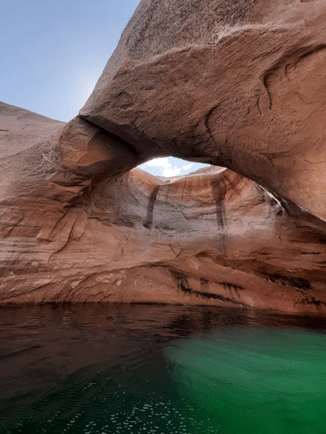Famous ‘Double Arch’ rock formation collapses in Utah – National

A 190-million-year-old rock formation has crumbled into the waters of Lake Powell, U.S. park officials announced.
The famous “Double Arch” geologic feature has towered over Rock Creek Bay in Utah’s Glen Canyon National Recreation Area since dinosaurs roamed the earth. Over its impressive lifespan, the rock formation battled the elements and gravity until it eventually collapsed on Thursday.
Photos show that the Double Arch formation used to form a ring suspended over the waters of Lake Powell at Rock Creek Bay. The recognizable shape lent the formation a number of nicknames, including “Toilet Bowl,” “Crescent Pool” and “Hole in the Roof.”

The ‘Double Arch’ rock formation in Glen Canyon National Recreation Area before it collapsed.
National Park Service
Officials don’t know the exact reason why the famous rock formation fell, but it’s believed that changing water levels in Lake Powell and erosion from the waves contributed to its collapse. There’s also the possibility that human interaction may have played a role.
“(T)his event serves as a reminder of our responsibility and need to protect the mineral resources surrounding Lake Powell. These features have a life span that can be influenced or damaged by manmade interventions,” Glen Canyon National Recreation Area superintendent Michelle Kerns said in a press release from the National Park Service (NPS).

Get breaking National news
For news impacting Canada and around the world, sign up for breaking news alerts delivered directly to you when they happen.
“While we don’t know what caused this collapse, we will continue to maintain our resource protection efforts on Lake Powell for future generations to enjoy. Please enjoy our resources but leave no trace.”
The Double Arch rock formation is made of Navajo sandstone, a particular kind of sandstone that is only found in America’s western states. The sandstone is the remnants of a vast and ancient desert, believed to be the largest known sand desert in the history of our planet, park officials say.
Underneath the desert’s windblown dunes, sand hardened into rock, leaving behind the Navajo sandstone. This process is believed to have occurred around the late Triassic to early Jurassic periods. Erosion from wind and water then carved out the arches and other formations Utah is famous for.
It’s understandably shocking for an ancient piece of history to crumble to the ground, but one park official says we should appreciate the processes by which nature makes and unmakes beautiful things.
Karen Garthwait, a spokesperson for Arches and Canyonlands national parks, told The Salt Lake Tribune that park officials in the past have decided against stabilizing precarious rock formations, choosing to let them fall naturally.
“Arches National Park doesn’t protect arches. It preserves the natural processes that both make arches and eventually unmake arches,” Garthwait said. It’s not the park’s mission “to stop time,” she added.
The Double Arch formation has been a popular hiking destination for decades for Glen Canyon’s millions of visitors. In 2023, more than five million people visited the park. Another rock formation called “Double Arch” exists in Arches National Park. This geologic feature is still intact.
© 2024 Global News, a division of Corus Entertainment Inc.









